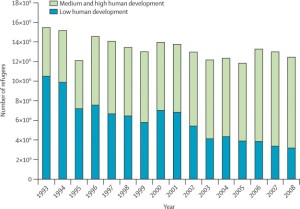Those people who dedicate their lives to addressing stressors among displaced populations are frequently faced with an uncomfortable truth: people under a lot of stress sometimes create more problems for themselves. This is a well-observed phenomenon across populations, and is generally known as “stress generation.” As regards trauma work, there is good research to show that the best predictor of future trauma is past trauma. For those of you not well-versed in stress generation, see Constance Hammen’s reflection on her career researching stress generation among depressed individuals in the Journal of Clinical Psychology.
The uncomfortable part of all this is that it can move quickly into “blaming the victim” (particularly as it pertains to trauma). If a combat veteran presents with PTSD and marital conflict due to the irritability and anger that is a part of the PTSD diagnosis, it can be very difficult not to get really frustrated with that vet’s anger and sink into “it’s your own damn fault” despite our initial sympathy. An automobile accident survivor has a higher likelihood of getting into another automobile accident than someone who hasn’t been in an automobile accident because the survivors tend to be extra cautious following their first accident, drive more slowly at the wrong times, get distracted by other drivers, etc.; if these things cause an accident, who is responsible?
When it comes to refugees, blaming the victim may result in less critical aid from the international community and stigma upon resettlement. And yet it’s clear to anyone who’s worked in refugee camps that a stressed population is a difficult population is difficult to work with. Indeed, one of the impetuses behind bringing psychosocial interventions into humanitarian aid is the danger that stressed refugees can pose to aid workers. There are numerous reports of refugees striking out against aid workers for small irregularities in aid distribution or changes in policies. (I should add that their are also striking reports of other refugees coming to the aid of aid workers.)
So how do we reconcile stress generation with our discomfort? Well, first by reminding ourselves that the first order of health provision is not morality. (I’ve harped on that before, and you probably don’t need to read it again here.)
Second, by looking further into stress generation research so we know what we’re talking about. In this literature, folks like Hammen make the distinction between “dependent, interpersonal” stressors and “independent, fateful” stressors. It turns out that research with people with mental health diagnoses have (on average) more stress-dependent events than people without mental health diagnoses, but have the same number of independent events. Dependent events are almost uniformly interpersonal in nature — and therefore plausibly related to how one would act towards others if really stressed. Independent events may be interpersonal, but their core feature is their fateful nature — they are not affected by how someone is acting.
How does the dependent-independent dichotomy map on to the typology of conflict-related stressors proposed in the last entry in this blog? Well, it’s pretty clear that mental health problems aren’t to blame for people being attacked or cause them to end up in unstable resettlement contexts — this is the “direct war exposure potentially traumatic events (PTEs)” category. For “collateral” and “other PTEs” (which, as I think through them may not be as distinguishable as they first seemed), the picture is less clear, and that some of these stressors are related to “being stressed” means that education campaigns surrounding the affects of stress (at the very least) are important. “Social ecological stressors” are clearly set off by displacement, but the breakdown of community institutions may be exacerbated by interpersonal problems. This is why the “social” in “psychosocial intervention” has always struck me as the more important of the two traditions. “Daily hassles” are likewise split between those problems that are outside of the control of the individual (e.g., a military checkpoint) and those that are exacerbated (unemotional reactions to hearing of abuse of loved ones). So perhaps the dependent-independent dichotomy is a second axis that runs through the typology proposed a few days ago. (Again, comments encouraged here.)
Important to remember through all of this is that all of these stressors are precipitated by an initial event — the event that was the cause of displacement. It would be difficult to argue that displacement events were dependent stressors. And yet many subsequent stressors, be they mild or traumatic, are dependent to some degree. In order to address these, humanitarian aid workers must remember the latter, and the former; they are equally important.

